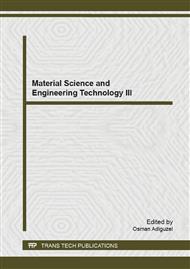p.3
p.8
p.15
p.20
p.28
p.32
p.36
p.40
p.46
Synthesis and Characterization of Aluminiun 2219 Reinforced with Boron Carbide and Molybdenum Disulfide Metal Matrix Hybrid Composites
Abstract:
An attempt has been made to develop and characterize the Al2219 reinforced with Boron carbide (B4C) and Molybdenum disulfide (MoS2) hybridcomposites. The hybrid composites were prepared by using stir casting technique. Theexperimentalresult evaluates the density,micro hardness test & tensiletest.Themicrostructure shows existence of randomly dispersed reinforcement particles andfine reinforcement particles in prepared hybrid composites.X-Ray powder diffraction (XRD) analysis were conducted this confirms the physical content of constituents present in prepared composites. SEM is used to examine fracture surface of tensile specimens for hybrid composites & this consists of ductile& brittle fracture of mixed mode.The test results revels that, themicro hardness and density is minimum for Al2219 and maximum for Al+3%B4C+5%MoS2. The tensile properties of the material vary according to the percentage of reinforcing material added.
Info:
Periodical:
Pages:
28-31
Citation:
Online since:
April 2015
Authors:
Price:
Сopyright:
© 2015 Trans Tech Publications Ltd. All Rights Reserved
Share:
Citation:


